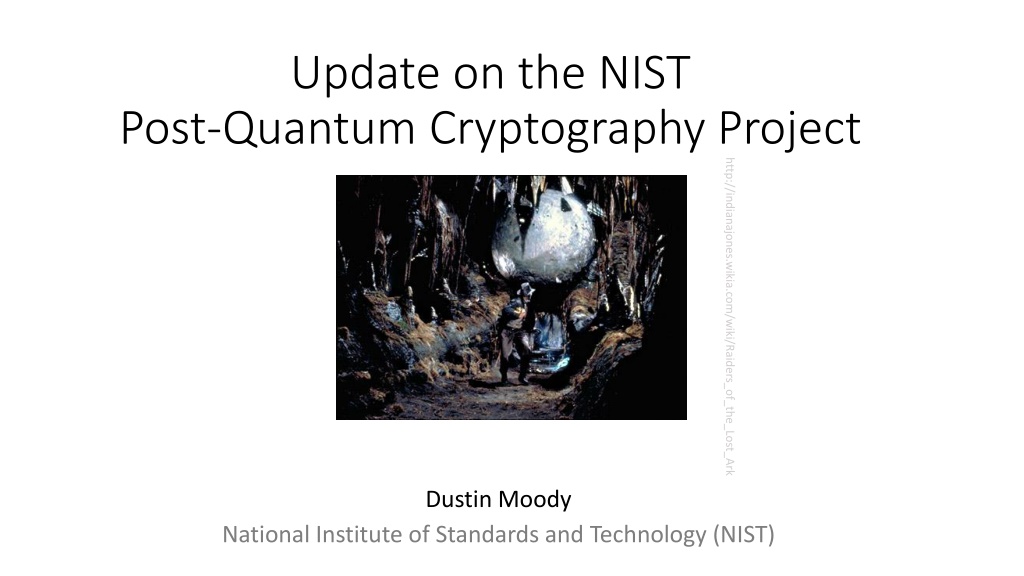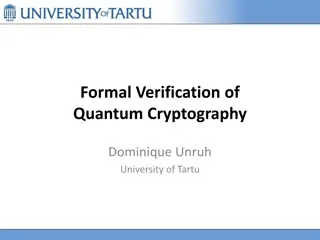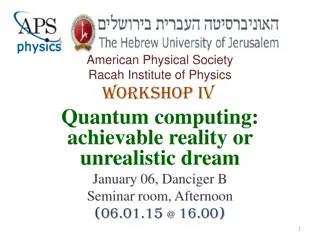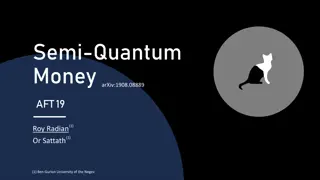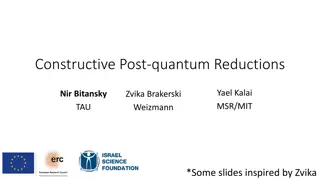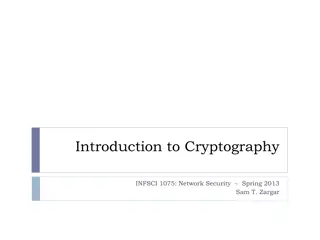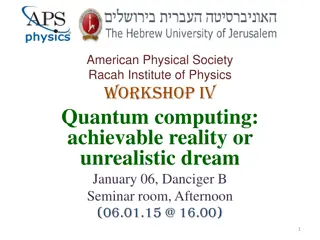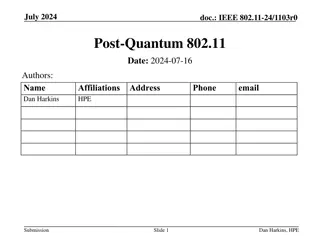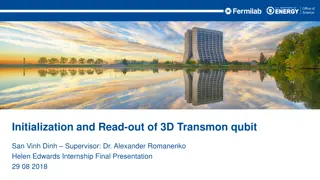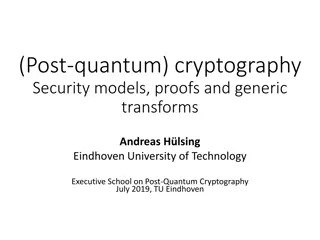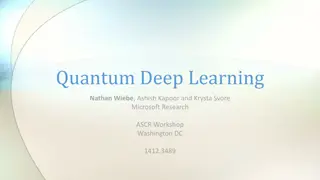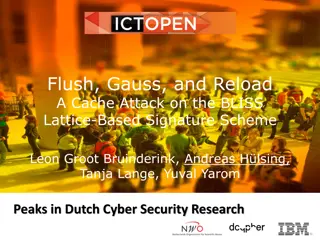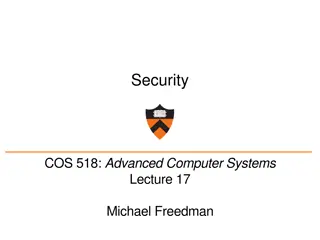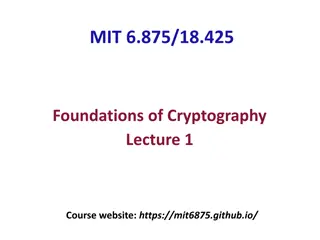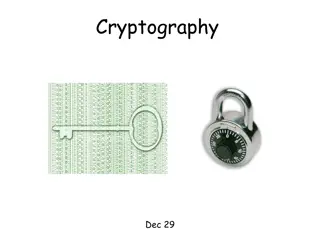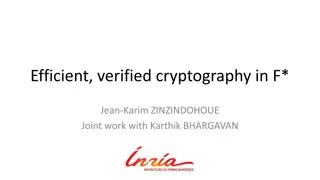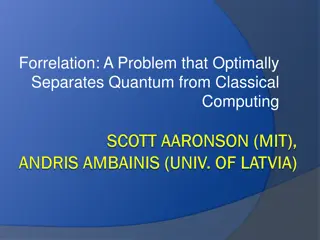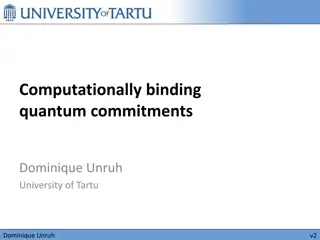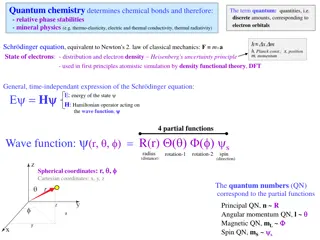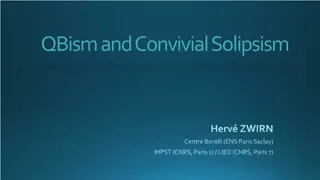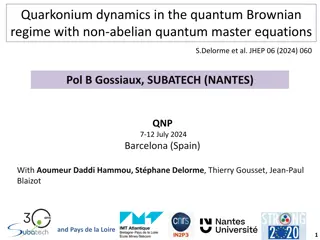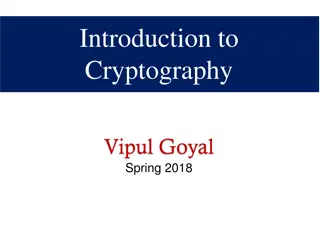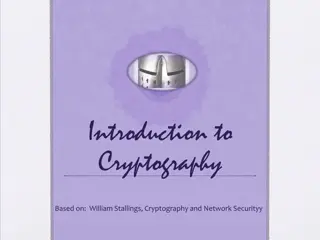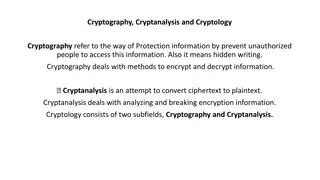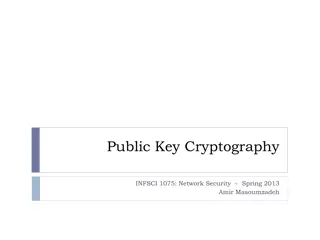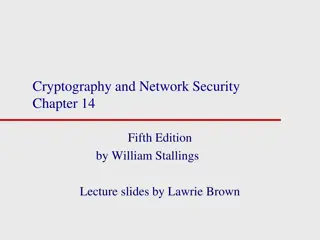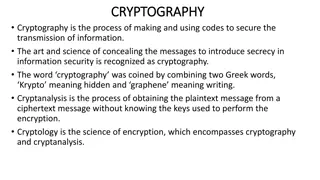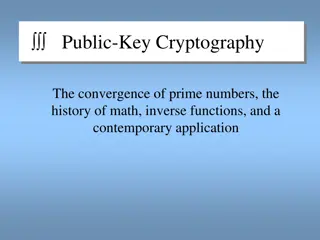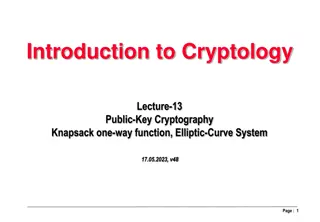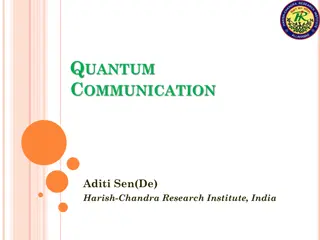Understanding Quantum Computing and Its Impact on Cryptography
Quantum computing utilizes the principles of quantum mechanics to process information exponentially faster than classical computers. This advancement poses a significant threat to current cryptographic systems, especially those reliant on factors like RSA and Diffie-Hellman key exchange. If large-scale quantum computers are built, the security of public key cryptography could be compromised due to their ability to break encryption algorithms quickly. This necessitates the development of quantum-resistant cryptographic methods to safeguard sensitive information in the post-quantum era.
Download Presentation

Please find below an Image/Link to download the presentation.
The content on the website is provided AS IS for your information and personal use only. It may not be sold, licensed, or shared on other websites without obtaining consent from the author. Download presentation by click this link. If you encounter any issues during the download, it is possible that the publisher has removed the file from their server.
E N D
Presentation Transcript
Update on the NIST Post-Quantum Cryptography Project http://indianajones.wikia.com/wiki/Raiders_of_the_Lost_Ark Dustin Moody National Institute of Standards and Technology (NIST)
Classical vs Quantum Computers The security of crypto relies on intractability of certain problems to modern computers Example: RSA and factoring Quantum computers Exploit quantum mechanics to process information Use quantum bits = qubits instead of 0 s and 1 s Superposition ability of quantum system to be in multiples states at the same time Potential to vastly increase computational power beyond classical computing limit
The Sky is Falling? If a large-scale quantum computer could be built then . Public key crypto: RSA ECDSA (and Elliptic Curve Cryptography) DSA (and Finite Field Cryptography) Diffie-Hellman key exchange Symmetric key crypto: AES Triple DES Hash functions: SHA-2 and SHA-3
The Sky is Falling? If a large-scale quantum computer could be built then . Public key crypto: RSA ECDSA (and Elliptic Curve Cryptography) DSA (and Finite Field Cryptography) Diffie-Hellman key exchange Symmetric key crypto: AES Triple DES Hash functions: SHA-2 and SHA-3
The Sky is Falling? If a large-scale quantum computer could be built then . Public key crypto: RSA ECDSA (and Elliptic Curve Cryptography) DSA (and Finite Field Cryptography) Diffie-Hellman key exchange Vulnerable NIST standards FIPS 186, Digital Signature Standard Digital Signatures: RSA, DSA, ECDSA SP 800-56A/B, Recommendation for Pair-Wise Key Establishment Schemes Discrete Logs: Diffie-Hellman, MQV Factorization based: RSA key transport Symmetric key crypto: AES Triple DES Hash functions: SHA-2 and SHA-3
The Sky is Falling? If a large-scale quantum computer could be built then . Public key crypto: RSA ECDSA (and Elliptic Curve Cryptography) DSA (and Finite Field Cryptography) Diffie-Hellman key exchange Vulnerable NIST standards FIPS 186, Digital Signature Standard Digital Signatures: RSA, DSA, ECDSA SP 800-56A/B, Recommendation for Pair- Wise Key Establishment Schemes Discrete Logs: Diffie-Hellman, MQV Factorization based: RSA key transport Symmetric key crypto: AES Triple DES Need longer keys Need longer keys Hash functions: SHA-2 and SHA-3 Use longer output
How soon do we need to worry? Potentially as early as 15 years to break RSA-2048 15 years, $1 billion USD, small nuclear power plant (Mariantoni, 2014) 50% chance (Michele Mosca) PQC needs time to be ready for applications Confidence cryptanalysis Implementations Usability and interoperability (IKE, TLS, etc. use public key crypto) Standardization Transition has to be soon enough that any data compromised by quantum computers is no longer sensitive when compromise occurs
Possible Replacements Lattice-based Code-based Multivariate Others Hash-based signatures Isogeny-based signatures Etc . All have their pros and cons
Initial Observations For most of the potential PQC replacements, the times needed for encryption, decryption, signing, verification are acceptable Some key sizes are significantly increased For most protocols, if the public keys do not need to be exchanged, it may not be a problem Some ciphertext and signature sizes are not quite plausible Key pair generation time for the encryption schemes is not bad at all No easy drop-in replacements Would be nice to have more benchmarks
Gathering Steam PQCrypto Workshop series ETSI workshops European PQCrypto project, Quantum flagship Japan s SAFECRYPTO project IETF hash-based signatures ISO/IEC JTC 1 SC 27 study period on PQC Fall 2015: NSA announced it would be transitioning in the not too distant future https://www.iad.gov/iad/programs/iad-initiatives/cnsa-suite.cfm
The NIST PQC Project http://www.nist.gov/pqcrypto Biweekly seminars since 2012 Guest researchers and invited speakers Research: publications and presentations PQCrypto, AWACS, ICICS, CRYPTO, Qcrypt, Eurocrypt, ETSI Quantum-safe workshops, etc. Out Reach PKI community, Automotive industry talks 2015: NIST PQC workshop http://www.nist.gov/itl/csd/ct/post-quantum-crypto-workshop-2015.cfm Feb 2016: NIST report on PQC- http://csrc.nist.gov/publications/drafts/nistir-8105/nistir_8105_draft.pdf Feb 2016: NIST announced preliminary standardization plan at PQCrypto https://pqcrypto2016.jp/data/pqc2016_nist_announcement.pdf
Collaboration IETF CFRG ISO/IEC JTC 1 SC 27 ETSI Workshops, white papers Universities University of Maryland (QuiCS) University of Waterloo (Cryptoworks 21) Guest Researchers and Speaker Lyubachevsky, Ding, Takagi, Petzoldt, Faugere, Gligoroski, Perret, etc
Timeline June 2016 Draft Call For Proposals released for public comment Fall 2016 formal Call For Proposals finalized Nov 2017 Deadline for submissions 3-5 years Analysis phase NIST will report its findings 2 years later - Draft standards ready (2023-2025) Workshops Early 2018 submitter s presentations One or two during the analysis phase
Call for Proposals NIST is calling for quantum-resistant cryptographic algorithms for new public-key crypto standards Digital signatures Encryption/key-establishment We see our role as managing a process of achieving community consensus in a transparent and timely manner We do not expect to pick awinner Ideally, several algorithms will emerge as good choices We may pick one (or more) for standardization Only algorithms publicly submitted considered
Differences with AES/SHA-3 competitions Post-quantum cryptography is more complicated than AES or SHA-3 No silver bullet - each candidate has some disadvantage Not enough research on quantum algorithms to ensure confidence for some schemes We do not expect to pick a winner Ideally, several algorithms will emerge as good choices We may narrow our focus at some point This does not mean algorithms are out Requirements/timeline could potentially change based on developments in the field
Minimal acceptability requirements Publicly disclosed and available with no IPR Signed statements, disclose patent info Implementable in wide range of platforms Provides at least one of: signature, encryption, or key exchange Theoretical and empirical evidence providing justification for security claims Concrete values for parameters meeting target security levels
Specification Implementation Reference version Optimized version Cryptographic API will be provided Can call approved hash functions, block ciphers, modes, etc Known Answer tests Optional constant time implementation
Evaluation criteria To be detailed in the formal Call Security Cost (computational and memory) Algorithm and implementation characteristics Draft criteria will be open for public comment We strongly encourage public evaluation and publication of results concerning submissions NIST will summarize the evaluation results and report publicly
Security Analysis Security definitions IND-CCA2 for encryption, EUF-CMA for signatures, CK best for key exchange? Used to judge whether an attack is relevant Quantum/classical algorithm complexity Stability of best known attack complexity Precise security claim against quantum computation Parallelism? Security proofs (not required but considered as support material) Quality and quantity of prior cryptanalysis
Target Security Levels Classical Security Quantum Security Examples I 128 bits 64 bits AES128 (brute force key search) II 128 bits 80 bits SHA256/SHA3-256 (collision) III 192 bits 96 bits AES192 (brute force key search) IV 192 bits 128 bits SHA384/SHA3-384 (collision) V 256 bits 128 bits AES256 (brute force key search)
Cost Computational efficiency Hardware and software Key generation Encryption/Decryption Signing/Verification Key exchange Memory requirements Concrete parameter sets and key sizes for target security levels Ciphertext/signature size May need more than one algorithm for each function to accommodate different application environments
Algorithm and Implementation Characteristics Ease of implementation Tunable parameters Implementable on wide variety of platforms and applications Parallelizable Resistance to side-channel attacks Ease of use How does it fit in existing protocols (such as TLS or IKE) Misuse resistance Simplicity
The Evaluation Process Initial evaluation phase (12-18 months) No tweaks/modifications allowed Workshops at beginning and end of initial evaluation phase Report findings and narrow candidate pool Second evaluation phase (12-18 months) Small modifications allowed Workshop towards end of second phase Report findings and narrow candidates Select algorithms for standardization or decide more evaluation needed
Call for Feedback How is the timeline? Do we need an ongoing process, or is one time enough? How to determine if a candidate is mature enough for standardization? hash-based signatures for code signing We are focusing on signatures and encryption/key-establishment. Should we also consider other functionalities? How can we encourage people to study practical impacts on the existing protocols? For example, key sizes may be too big
Conclusion NIST is calling for quantum-resistant algorithms We see our role as managing a process of achieving community consensus in a transparent and timely manner Different from (but similar to) AES/SHA-3 competitions PQC Standardization is going to be a long journey We don t have all the answers Be prepared to transition to new (public-key) algorithms in 10 years The transition will not be painless NIST will provide transition guideline when PQC standards are developed Prepare the application designers Focus on crypto-agility
